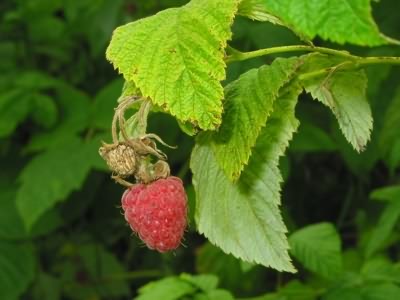Crops
Rubus idaeus L. - Raspberry
Taxonomy.
Family Rosaceae Juss., genus Rubus L.Morphology and biology.
2n=14. Shrub has perennial root system, which consists from rhizome and additional roots, and crone consisted from annual and biennial shoots. Roots go into the depth 40-50 cm and grow in sides on 40-300 cm from the center of shrub. Unlike other berries shrubs, shoot lives two years only. At the first year green weekly- acanthaceous shoots grow, reaching 1.5-2 m to the autumn. At the second year shoots become ligneous and brown. Leaves are oval, alternate, with leafstalk, compound, with 3-7 ovate leaflets. Upper leaf surface is dark green and lower leaf surface is whitish, pubescence with small piluses. Mixed buds are formed in leaf axil, on the second year side shoots with small clustery inflorescence grow from them. Flowers are white, bisexual, self-pollinated, about 1 cm diameter. Blossoming from June to July during 20-25 days. Fruit - combined numerous drupelets red, yellow or black color, sits on proliferative receptacle. Fruit weight is about 3 g (up to 6 g). Main harvest is formed on the middle part of the shoot. High harvest shrub gave after 2-3 year after planting.Distribution and origin.
Species is in culture from 3 century BC. In Eastern Europe it is cultivated from Middle Ages, in Russia - from 12 century AC. Sorts originated from two species generally: Rubus idaeus L. - Red raspberry and R. occidentalis L. - Black raspberry. In Russia raspberry is cultivated in Siberia, Ural, Volga region, Central region, the main plantings are in Western Siberia.Ecology.
Plant does not like as abundance of water, as drought. Photophilous. Moderate requested to heat: optimal temperature for growth and development 18-25 °C. For the fruit ripening and shoots preparing to winter time it is needed vegetation period 130-160 days, with sum of temperatures above 10°C not less than 1300°C. Under snow cover plant can survive frost -40-45°C. High demanded to soil fertility. Prefer flat slopes with not heavy and well-drained soil, which has subacid or neutral pH, and contains enough quantity of humus and elements of mineral nutrition. Frost-resistance decreases by abundant nitrogen, over-wetting, or after long-drawn-out rainy autumn. Plant well adapts to different nature-climatic conditions.Economic value.
Berries contain 6-12% sugars, 0.7-2.3% organic acids, 0.5-2.0% pectin, salts of phosphorous, iron, magnesium, calcium, tannins, vitamins C 34.0-46.4 mg/100g, and vitamins A, B1, B2, B9, B12, E, P. The berries are eaten fresh, used in dry, or frozen state, and for cooking juice, jelly, marmalade, fruit drinks. Main sorts: Barnaul'skaja, Novokitaevskaja, Novost' Kuz'mina, Aborigen, Alyi parus (early rape); Vislukha, Nagrada, Newburg, Rubin bolgarskiy, Zhuravlik, Kenbi, Kirzhach, Nagrada (mid-season); Latam, Melodia, Sputnitsa (late-ripe). In addition to them there are other sorts: Kitaevskaya, Progress, Kaliningradskaja, Malboro, King ect. Productivity 4-5 kg per bush, 4-6 (up to 10) ton per hectare. Valuable medicinal plant, extract from dry fruits and leaves is used for precautions of catarrhal diseases, and as febrifuge means. Honey plant (gives up to 59-116 kg honey per hectare). Some sorts are used as ornamental plants.Reference citations:
Cherepakhin V.I., 1991. Culture of currant and raspberry. Lections. Moscow: All-union agricultural institute of extra-mural education. 33 p. (in Russian).Diakonova T.I. (ed.), 1980. Technology of raspberry cultivation on the plantations with interrupted cycle of bearing (recommendations). Moscow: Rosselkhozizdat. 43 p. (in Russian).
Kazakov I.V., 1994. Raspberry and blackberry. Moscow: Kolos. 141 p. (in Russian).
Lushchits G.E. (comp.), 2001. Berries bushes: currant, raspberry, blackberry, gooseberry. Minsk: Knizhnyi Dom. 80 p. (in Russian).
New technology of raspberry cultivation with maximal mechanization of industrial processes in condition of Siberia. Novosibirsk: Zapadnosibirskoe knizhnoe izdatel'stvo, 1978. 51 p. (in Russian).
Vitkovsky V.L. Fruit plants of the world. St.Petersburg-Moscow-Krasnodar: Lan, 2003. 592 p. (in Russian).
Yaroslavtsev E.I., 1987. Raspberry. Moscow: Agropromizdat. 207 p. (in Russian).
Yaroslavtsev E.I., 1991. Raspberry. Moscow: Agropromizdat. 41 p. (in Russian).
http://ru.wikipedia.org/


